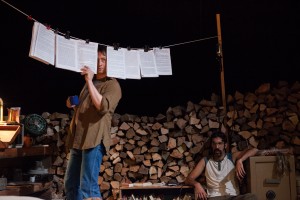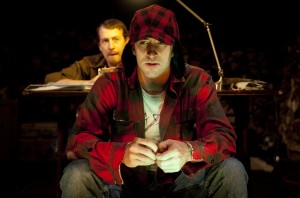In the Ice Factory Festival’s run thus far, no play has managed to reconcile the New Ohio Theatre’s intimate space with the magnitude of its subject matter as well as George and Co.’s production of Holden. The wrathful claustrophobia that Holden emanates very quickly imbibes the audience itself, and we find ourselves shifting uncomfortably in our plush blue seats. But it doesn’t begin that way. We are lulled into enjoying the sarcastic dialogue, the self-aware movements of the actors and Billie Holiday’s sad voice, which croons occasionally as part of the play’s soundtrack. But this false security is made all the more frightening by the individual character revelations that slowly begin to transfigure and twist the production into an entirely unexpected and strangely arresting creature.
The set is an organic element of the story: its walls of chopped logs and floors of wood chips create a color scheme of unending amber brown. Typed-up sheets of paper hang from a clothes line. It is evidence that we are in a writer’s island. There is a spare cot, shelves stacked with books and a detective-like desk with a reading lamp, typewriter and magnifying glass. And everywhere, crumpled balls of paper litter the furniture and the floor. Holden already seems overly cramped in its setup, and we wonder how its actors will negotiate the space, but this is a calculated move on the part of scenic designer Nick Benacerraf.
Writer-director Anisa George notes that Holden exists “in an impossible time and place,” lending an otherworldly tint to the log bunker in which her story is set. Four figures lie sleeping in the darkness as crickets chirp drowsily outside. One man gets up, quietly turns on a reading lamp and opens up J.D. Salinger’s novel, The Catcher in the Rye. His name is Hinckley (Scott Sheppard) and he begins to retype the entire book, word for word, with a typewriter set in front of him until the tall, side-burned and bespectacled figure of Chapman (Jaime Maseda) stops him. Both Chapman and Hinckley are devotedly respectful to the pajama-clad, white-haired Jerry Salinger (Bill George), who wakes up from a war-torn nightmare (the real Salinger took part in the hellish storming of Normandy on D-Day), but Zev (Matteo Scammell) seems to be on equal terms with the author.
Zev, a serious young man in torn jean-shorts and a red flannel shirt is the "new guy," as Chapman and Hinckley derisively christen him. It is not until the closing stages of Holden that the two start calling him by his name. A little girl called Peggy (Adele Goldhader) is the only one who is able to enter and exit the bunker; she appears to be Salinger’s 10-year-old daughter, and keeps urging him to return to the rest of his family. But Salinger pays little attention to his environs, even completely disregarding his three bunkmates as he fusses and fumes with his writing.
As the play progresses, it becomes evident that Chapman and Hinckley are infamous men. The former is Mark Chapman, the man who killed John Lennon in 1980, and his compatriot is John Hinckley, Jr., the man who attempted to assassinate Ronald Reagan in 1981 (a sore point for him since he couldn’t "finish the job" as Chapman did). Both men were apparent lovers of The Catcher In the Rye, rationalizing their murderous intents with Holden Caulfield’s disdain for "phonies." Hinckley was famously obsessed with Jodie Foster’s character in the movie Taxi Driver, as George funnily references before she reveals the character’s true self, but still he and Chapman are scarily similar. When Jerry (in the play) writes down one sentence in a fit of inspiration and falls back asleep, his two fans are rendered speechless by his words: “In his mind, fulfillment meant loving a good woman and killing a bad man.”
George cleverly introduces her characters with relative anonymity. Maseda makes Chapman seem like a hyperactive publisher or agent, impatiently keen on the release date for Jerry’s new book. Sheppard renders Hinckley as a comically bumbling figure, interacting innocently with his environment. It is only Zev, played to ominous ferocity by a supremely talented Scammell, who remains unknown to us until the end. Why is he being held in this purgatory-like fan land with such company as Lennon’s killer and Foster’s stalker? He doesn’t even like Salinger, and thinks Holden is “kind of a loser” to the utter shock of his fellow bunkmates. We soon find that George has created an even more terrifying character in Zev, one especially menacing to the modern American. He is the nameless, unselective kind of killer who rejoices in the power of guns and in closed, packed places. Even Chapman and Hinckley are disgusted by him, and it is with a bloodcurdling, knowing shiver that we hear Zev’s words: “I don’t like people. I like maps...blue prints. I like to see where the entrances and exits are. Public places. Stadiums. Schools. Theaters.”
The audience is flooded with memories from the country’s collective consciousness: Sandy Hook Elementary, a movie theater in Aurora, Colorado, and a church in Charleston, South Carolina. We see the second generation of American violence in Zev, and it is an aimless, indiscriminate violence borne not out of emotion, but detached cruelty. Zev’s fight isn’t against "the phonies" like Chapman and Hinckley. His violence doesn’t require reason or impetus, but merely opportunity. This complete shift in tone and performance that quietly occurs halfway through the play is an unflagging testament to George’s intelligent directorship and riveting dialogue. Holden merits a visit, and it almost seems like a citizen’s requirement, as we remain mired in the sorrows of modern violence.
Holden ran from August 6-8 at the New Ohio Theatre (154 Christopher St., #1E between Greenwich and Washington Sts.) in Manhattan. For more information, visit www.newohiotheatre.org.








